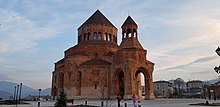Stepanakert in the Republic of Artsakh
From the breakup of the Soviet Union in 1991 to the 2023 Azerbaijani offensive in Nagorno-Karabakh, the city of Stepanakert was the capital of the unrecognized breakaway Republic of Artsakh, while being internationally recognized as part of Azerbaijan.
The economy was based on the service industry and had varied enterprises, food processing, wine making, and silk weaving being the most important.
[5] During the period of the USSR, Stepanakert served as the capital of the Nagorno-Karabakh Autonomous Oblast within the Azerbaijani Soviet Socialist Republic, between 1923 and 1991.
With the self-declared independence of Artsakh in 1991, Stepanakert continued with its status as the political and cultural centre of the newly established republic, being home to all the national institutions: the Government House, the National Assembly, the Presidential Palace, the Constitutional Court, all ministries, judicial bodies and other government organizations.
[17] Though originally scheduled to launch the first commercial flights on 9 May 2011, Karabakh officials postponed a new reopening date throughout the whole of 2011.
[18] In May 2012, the director of the NKR's Civil Aviation Administration, Tigran Gabrielyan, announced that the airport would begin operations in summer 2012.
The OSCE Minsk Group, which mediates the Nagorno-Karabakh conflict, stated that "operation of [Stepanakert Airport] cannot be used to support any claim of a change in the status of Nagorno-Karabakh" and "urged the sides to act in accordance with international law and consistent with current practice for flights over their territory.
The economy was based on the service industry and had varied enterprises, food processing, wine making, and silk weaving being the most important.
Prior to the First Nagorno-Karabakh War, the economy of Stepanakert was mainly based on food-processing industries, silk weaving and winemaking.
Artsakh Hek was the leading construction firm, while Base Metals was the leader in mining and production of building materials.
[28] The Artsakh State Museum, based in Stepanakert, had an important collection of ancient artifacts and Christian manuscripts.
[4] Five higher educational institutions operated in the city: Many new schools in Stepanakert were opened from the late 1990s to 2010 with the help of the Armenian diaspora.
[38][39] The following month, on 21 October 2012, Artsakh played the return match at the Stepanakert Republican Stadium against Abkhazia, winning it with a result of 3–0.
[41] As an unrecognized entity, the athletes of Artsakh competed in international sports competitions under the flag of Armenia.






